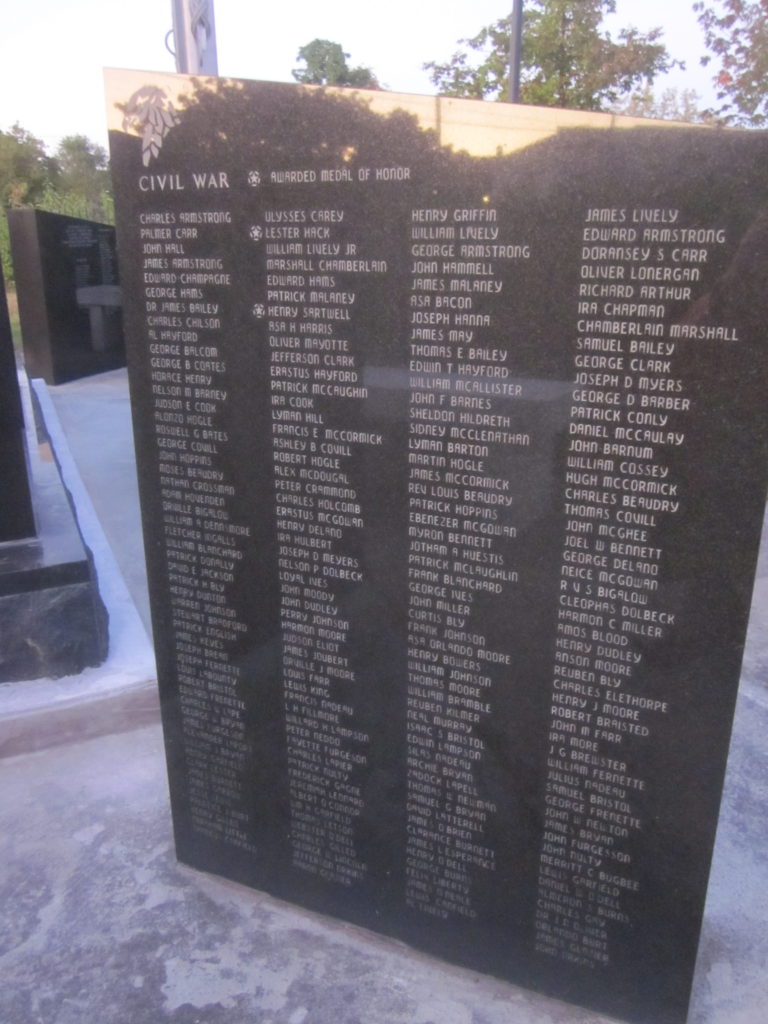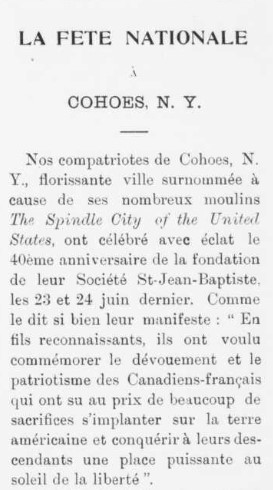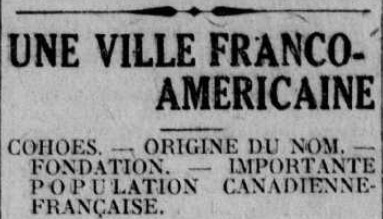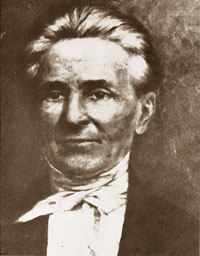Prior posts in this series include studies of Exeter, Somersworth, and Berlin, New Hampshire. For research on early migrations to economic hinterlands, please see my posts on the Revolutionary War veterans in New York State, early migrations, the formation of hinterland communities, and numerical assessments.
In the last two weeks, I had the immense pleasure of sharing my research on the Franco-Americans of Upstate New York at two events, Fort Ticonderoga’s Seminar on the American Revolution and the annual meeting of the American-Canadian Genealogical Society. To be clear, it is not that I particularly enjoy hearing myself talk; nor am I ever imparting some kind of universal truth. These were worthwhile events because of the informal conversations I had with attendees, who, having their own stories to share, enriched my perspective.
At both events I was approached by individuals who have in their ancestral lineage a French-Canadian Patriot—a Patriot of the 1775-1776 kind, rather than a Patriote de 1837-1838. I heard from a woman who grew up in Ogdensburg, New York, where she was taught by French-speaking nuns from Ottawa. There was a man who at one time attended the services of the French national parish of St. Peter in Plattsburgh. Some attendees showed a keen awareness of the French-Canadian heritage of such places as Massena and Washington County. Oh, and there was a couple that recounted a near-miss involving Professor Allan Everest at SUNY–Plattsburgh. (I need to hear that entire story, by the way, Michael and Marty.)
I tend to deluge fellow researchers with an inordinate amount of “further reading.” “Don’t take my word for it,” I want to say. It is my way of highlighting others’ outstanding research, which easily fades to obscurity if it is not instantly impactful. In the same spirit, minus an overwhelming number of outside references, I offer a few pistes for further research on New York State to honor some of the questions I received.

Upstate
My latest talks were as rewarding as my prior travels to the western shore of Lake Champlain—minus cryptic references to accidental academic purges. In Rouses Point, for instance, I was welcomed (and aided in my research) by a man whose French-Canadian ancestor was a “Baril.” From the artifacts of Ticonderoga to the toponyms of Plattsburgh and plaques of Chazy, there was also ample material evidence attesting to French Canadians’ presence in this northern region.
A lot of that material still lies in local archives, but a recent book by Kimberly Lamay Licursi and Celine Racine Paquette, Franco-Americans in the Champlain Valley (2018), has brought photographs out of their dark resting places to highlight the Franco-American heritage of both shores of Lake Champlain. It offers valuable context and ample inspiration for further explorations of the subject—and inspiration for actual exploration of Franco life in the region. On the web, one must-stop place for researchers with genealogical and local interests is the FrancoAmerican Gravy blog.


Hudson Valley
For those who have access to academic journals and platforms, many of which are sadly guarded by paywalls, there is excellent scholarship on Franco-Americans in the mill towns of the middle Hudson. Just as Sylvie Beaudreau and Susan Ouellette have undertaken research on Clinton County, we find equally significant studies of the Cohoes–Troy–Albany region by Eloise Brière and Cynthia Fox. As noted previously on this blog, Siena College’s Janet Shideler is working to also bring French-Canadian material culture out of private collections and into the digital realm to increase access. A few more pistes:
Labor scholar Daniel Walkowitz’s Worker City, Company Town: Iron and Cotton-Worker Protest in Troy and Cohoes, New York, 1855-84 (1978) provides a valuable point of entry into the area’s economic dynamics.
For something completely different, see J. I. Wyer on metropolitan French settlements in New York State in the late eighteenth century. This is not French-Canadian history per se, yet it does reveal the complexity of the state’s “French Connections” and can help disentangle French names that pop up in the midst of research.
New York City
Beyond the stories that audience members generously and graciously shared, I found one question particularly challenging. In Manchester, an ACGS member asked whether Franco-Americans in New York City had had their own national parish. I vaguely recalled reading of one. Well, a little bit of additional research confirms that they did, although the parish seems to have attracted a diverse following from the beginning. A worthwhile read is J. Jehin de Prume’s Les Canadiens-Français à New-York (1920), which traces the origins of the local société Saint-Jean-Baptiste as well as the founding of the eponymous parish. That parish, by the way, is still alive and well. Its website includes a lengthy local history in PDF.
The question is a helpful reminder that the Franco-American story requires further exploration not merely in geographical peripheries; in the largest cities, too, that story is still obscured by limited research. In New York City and in Boston, French Canadians amounted to only a very small portion of the city population, even when their absolute numbers could be quite considerable; when the immigrants clustered together, theirs was not a Little Canada of the kind seen in Lowell. In 1910, there were over 6,000 identifiable French Canadians in New York City and nearly 10,000 in Boston. Who will tell their unique story?

Through my talks in Ticonderoga and Manchester, I hoped to show that the Franco-American history of New York State is no more dead and buried than that of New England, although I regret to see that it is mostly the oldest generation that keeps its memory alive. If nothing else, historians can ensure that if younger Americans do not hear about their own background in the home, they will be forced to acknowledge it in the classroom. There they may approach that past critically and appreciate its significance in the larger arc of U.S. history.
This post is meant to whet readers’ and researchers’ appetite. I am happy to provide a more comprehensive list of Franco-American works by request; many of those also appear in my Bibliography, which is keyword-searchable.
Pingback: This week’s crème de la crème — October 5, 2019 | Genealogy à la carte
I have heard that during the Revolutionary War the American’s offered land in Plattsburgh, NY to any French Canadians willing to fight the British on their behalf. I am seeking information on this as my family goes back several generations in Plattsburgh and can trace their heritage back to Canada in the 1600’s. One family name is Pariseau and Jacques Parizeau, although not in Plattsburg, is on this tree.
Katherine, if I may: Yes, many of the French-Canadian soldiers and officers who had fulfilled certain terms of service were offered land grants after the war. However, many quickly sold those plots without ever occupying or improving them; those who did settle were mostly concentrated in and around Chazy. Census returns from 1790 and 1800 are available on Ancestry.com; you might be able to find your ancestors there. That being said, a much larger group of French Canadians migrated to Plattsburgh and to Clinton County as a whole from the 1840s to the end of the nineteenth century. You might have more luck tracing your immigration story through this period.
Mr. Lacroix.,
I just came across this article. I was hyped because today January 5, 2023, I began a course on the French in Plattsburgh with Susan Ouellette. As I read the article I noted that I knew almost everyone.
We need to talk. Send me an email so we can set something up. David
Great article. Email me
I have significant family history in this area. Constantly searching for the Dupuis, Dupuy, Dupee family…
Looking forward to see what can be discovered.
many thanks
The influence of French Canadians in Northern NY–specifically the counties of St. Lawrence, Franklin and Clinton–went well beyond these immigration waves. Those areas, for many years in my lifetime, also had media that primarily came from Quebec (and Ontario) 3 out 4 TV channels we has in SLC were in French before the advent of cable, satellite and internet TV. In addition, living in close proximity to QC and being geographically isolated from the rest of NYS has les to a north country culture eapecially connected to Canada. I’m curious if you can point me to any resources that focus on that specific area of NYS. My own family came largely from VT but one branch did come from Canada to Massena.
Hi Abi. Good points. It’s the same in my area of northern Maine, where the TV signals were nearly all Canadian. Unfortunately, scholars of Franco-American history have consistently neglected St. Lawrence County, so, if you are searching Franco-American literature specifically, you may come up empty-handed. A small exception may lie in the online collections of the Je Me Souviens project [https://nyheritage.org/collections/je-me-souviensi-remember-presenting-and-preserving-heritage-upstate-new-yorks-franco]. I will have an article on the state’s Franco population in the upcoming issue of New York History; however, because my focus is statewide, references to Ogdensburg are few and far between. You’re likely to have more luck with works of local history that happen to mention French Canadians, like David Martin’s books on Ogdensburg and (with Theresa Sharp) on Massena, both published by Arcadia. There is a site with historical images [http://www.ogdensburg.info/] and NYS Historic Newspapers is a great starting point for original material on French Canadians [https://nyshistoricnewspapers.org/]. Perhaps your local historical societies would also have fruitful leads. But, in the absence of a book on the French-Canadian history of SLC, you may have to be the one to write it!
Thank you for all the work and research you have contributed with these articles! I have become so invested in Franco American history, particularly in NYS. Growing up, I remember several of my peers and teachers having French ancestry, including my guidance counselor whose last name was LeBlanc. However, I am from the NYC area. Reading about the St. Jean Baptiste church was interesting, as not only are they alive and well but masses in French are still given. Prior to the creation of St Jean Baptiste, there was also the St. Vincent de Paul church (which is no longer open, sadly).I think Bishop de Forbin Janson commissioned the construction of both churches. He lamented that the French Catholics did not have their own national parish in the city, like the Irish and Italians. The Bishop challenged them to create one and would take time out of his busy schedule to visit and see the progress being made. Also, in the 19th century, there used to be a “Little Paris” in the Soho area of Manhattan. The enclave lasted for 20 years and it’s estimated that around 20,000-24,000 French immigrants were living there. Anyways, I’m looking forward to your upcoming article about New York and its Franco-American population!
Henry: Thank you for reading! Thank you, also, for sharing these historical nuggets. I still don’t know nearly enough about the French-Canadian presence in New York City, but I will keep at it. It’s research that stands to enrich how we view the Franco-American world.